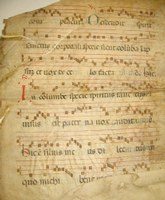Medieval Parchment

The Jyväskylä University Library owns a single parchment leaf originating from a Catholic antiphonary, dating from about 1450. An antiphonary displays the songs sung in the divine office. In Lutheran terms, we would now talk about a hymn book and a page torn from it.
Information about the parchment was provided to the Library by Outi Merisalo, professor of Romance philology, scholar and bibliophile specialized in old books. Professor Merisalo examined the parchment leaf and gave a full Finnish description (pdf) of it.
The precise origin of the parchment is unknown, but it probably comes from central Italy, Tuscany, Umbria, or the region of Rome.
Written on the leaf, two-sided, in beautiful and masterly handwriting, is an extract of songs sung in the vigil during Epiphany. The size of the leaf is 45 x 35 cm. “The book had to be big, because the whole choir needed to see what was written on it,” says Professor Merisalo.
The parchment was donated to the Library by M.A. Stina Wilén, who had bought it in Florence in 1958. Funds permitting, the parchment will be restored.
The Parchment
- Material: Parchment, i.e. treated skin, was still used in the 15th century. Paper, which was a cheaper material, replaced parchment in books almost completely in the second half the 15th century.
- Writing: Handwritten. Printing spread only after the mid-15th century.
- Font: Locates the leaf to Italy. Written in Italian Gothic writing, littera textualis formata rotunda, used especially for writing ceremonial and valuable books. Used from the mid-14th to the early 16th centuries.
- Embellishment: Simple. Blue and red initials that were used in the mid-15th century, sometimes earlier.
- Stave: The four-lined stave refers to the 15th century at the latest. The five-lined stave used today became common outside France only a little later.
- Earlier research: Illustrated catalogues of manuscripts in various countries. They contain the dates, places and scribes or any of these of the manuscripts.
- Difficulties: No precise information about the original place of writing or location. Similar texts were used all over Europe. No mention of songs that would correspond to the songs of the calendar of the saints and thus help define the location. There are saints who were worshipped in a certain region or town.
- Scientific cooperation: Professor Merisalo consulted with French and Italian scholars.
Sources:
Professor Outi Merisalo, Jyväskylä University, Department of Language and Communication Studies